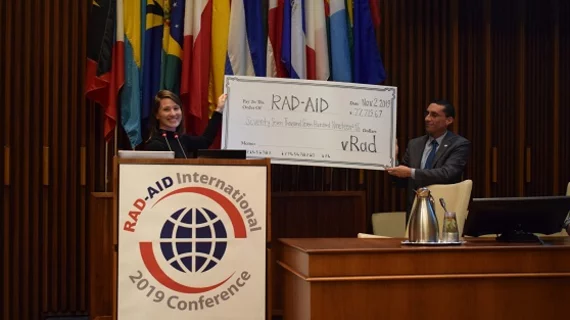Q&A: How teleradiologists are helping underserved regions all over the world
What happens when patients who need medical imaging have nowhere to turn? How can they find treatment when the necessary resources aren’t even available?
More than 4 billion people throughout the world lack access to medical imaging, according to statistics shared by the nonprofit organization RAD-AID. The teleradiologists at vRad, a MEDNAX company, decided to do something about it.
vRad radiologist Joshua Sokol, MD, initially developed the First Read Initiative (FRI) in 2018 to help tackle this problem. We spoke with Dr. Sokol about the initiative, why it’s so important and how he thinks it might evolve in the years ahead.
What is First Read Initiative and how did it come about?
The mission of FRI is to help bring medical imaging and support technology to patients in underserved regions around the globe. Over the years, many of us at vRad volunteered to read films for organizations like Doctors Without Borders and Haitian Relief. It was very satisfying work, but many of us felt we could do more. By leveraging vRad technology and this desire to help, the FRI was born.
Our initial idea was to send medical equipment to underserved areas, but we soon realized the problem was far more complicated. Most of these patients and practitioners have no access to imaging equipment, let alone a technician to operate it, electricity to power it or an Internet connection to deliver it to a radiologist halfway around the world. We couldn’t just send equipment. We needed to empower the people on the ground. To do that, we had to first provide them with financial resources, imaging technology and education. Only then could our interpretive skills be of any use.
We may not always be able to travel to remote areas around the world to provide hands-on care, but we can contribute valuable funding and diagnostic expertise to the medical teams onsite from the chairs in our reading rooms. That’s what FRI is all about.
How did you get started? It seems like that would be quite the project to organize and get off the ground.
At first, it did seem overwhelming. But then I connected with a number of great organizations already delivering diagnostic resources to disadvantaged areas all over the globe—organizations such as RAD-AID, Project C.U.R.E. and UnitsUSA—and their experience helped us immensely.
Instead of reinventing the wheel, we decided to “help the helpers” by setting up a system where any of vRad’s 500+ radiologists can automatically donate their earnings from their first x-ray of every shift (or more if they wish) to a general fund that goes to support many radiology charities. The radiologist simply signs up for the program, logs in for their shift and begins reading. All of the logistics are taken care of for them.
With over 500 radiologists connected by the MEDNAX Imaging Platform, one of the most advanced communications and workflow systems in the medical industry, we are in the best position to respond to this need. In less than 1 year, FRI was able to fund equipment purchases, technologist training and the first-ever simulator-based interventional radiology training in Vietnam.
The initiative recently celebrated its first anniversary. What are your thoughts on that initial year?
I’m very excited and encouraged to redouble our efforts. We raised over $114,000 in our inaugural year and we are on track for a 15-20% increase in our second year. We were able to purchase an ultrasound machine for training technologists all over the world and provide computers and diagnostic monitors to support a hospital in Georgetown, Guyana. We sponsored trainees in Guyana so they could attend a CME conference in Las Vegas, improved radiation reduction education at a pediatric hospital in Thailand and brought mobile ultrasound services to rural Appalachia.
There is still a lot more to do, of course, but we’re off to a great start.
What’s next for the First Read Initiative?
We’re really focused in two key areas. First, increasing participation within our own practice and collaborating with other radiology practices. We could generate more contributions that way and make a much greater impact.
Second, as we work with other charities to purchase, transport and implement imaging systems, we also want to help them develop a better mechanism for offering charitable radiology interpretations. We’re the most robust teleradiology group in the world, so we could leverage our size and scale to have a major impact in developing radiology services around the world.
What about looking even further into the future? What are some really long-term goals for the initiative?
Down the road, we’d love to develop a capability where studies from all over the world could be sent to us and read by any licensed teleradiologist that logs in to provide an interpretation. It will take a while to get there, but that’s something we certainly have our eyes on.
If you’d like to learn more, stop by vRad's booth at RSNA. Click here for booth locations and a listing of the company's RSNA events.

